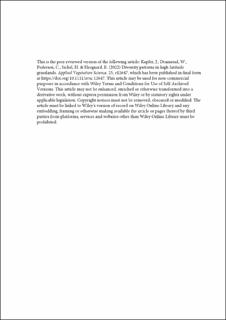| dc.description.abstract | Aim Grasslands of varying land-use intensity and history were studied to describe and test species richness and compositional patterns and their relationships with the physical environment, land cover of the surrounding landscape, patch geometry, and grazing. Location The mainland of Norway. Methods We utilized data from the Norwegian Monitoring Programme for Agricultural Landscapes, which recorded vascular plants from 569 plots, placed within 97 monitoring squares systematically distributed throughout agricultural land on the Norwegian mainland. We identified four grassland types: (i) moderately fertilized, moist meadows; (ii) overgrown agricultural land; (iii) cultivated pastures and disturbed ground; and (iv) natural/unfertilized and outfield pastures. Results Soil moisture and grazing measures were found to be important in explaining species compositional variation in all grassland types. Richness patterns were best explained by complex and differing combinations of environmental indicators. Nevertheless, negative (nitrogen and light level) or unimodal (pH) responses were similar across grassland types. Vegetation plots adjacent to areas historically and/or currently dominated by mires, forests, or pastures, as well as abandoned and overgrown grasslands, had a slightly higher species richness. Larger grasslands surrounding the vegetation plots had slightly less species than smaller grasslands. Conclusions This study demonstrates that data from a national monitoring programme on agricultural grasslands can be used for plant ecological research. The results indicate that climate-change-related shifts along moisture and nutrient gradients (increases) may alter both species composition and species richness in the studied grasslands. It is likely that large and contiguous managed (grass)land might affect areas perceived as remnants, probably caused by the transformation to homogeneous (agri)cultural landscapes reducing edge zones, which in turn may threaten the species pool and richness. The importance of land use and land-cover composition should be considered when planning management actions in extensively used high-latitude grasslands. | en_US |
